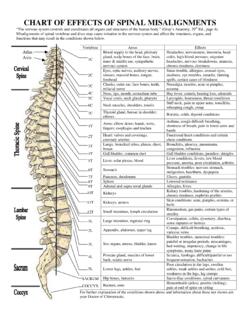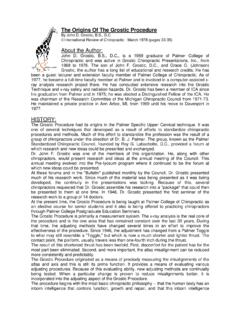Transcription of Sympathetic Segmental Disturbances - Dan Murphy
1 1 Sympathetic Segmental DisturbancesThe Evidences of the Association, in Dissected Cadavers, of VisceralDisease with Vertebral Deformities of the Same Sympathetic SegmentsMedical Times, November 1921, pp. 1-7 Henry Winsor, MDTHIS AUTHOR NOTES: The object of these necropsies was to determine whether any connection existedbetween minor curvatures of the spine, on the one hand, and diseased organs onthe other. This author used 50 cadavers from the University of of the 50 cadavers displayed minor curvatures of the spine, and 1 cadaverdisplayed the normal slight smooth lateral curve in the thoracic spine. This 1 cadaver still showed very minor visceral pathology in the segmentsimmediately above and below the reported curve, at segments which should formcompensatory curves.
2 All [other] curves and deformities of the spine were rigid, apparently of longduration; irreducible by ordinary manual force: extension, counter-extension,rotation, even strong lateral movements failed to remove them or even cause themto change their relative positions. Importantly, minor spinal curvatures their association with disease of organsbelonging to the same Sympathetic segment is more frequent than with grosscurves. Also importantly, in the 4 spines with gross curvatures diseased organs were notfound to belong to the same Sympathetic segments as the gross curves, but were[found at] the same Sympathetic segments as the minor compensatory curvaturesabove and below the greater curves. 2 Visceral DisturbanceVertebral Curvatures OfThe Same SympatheticSegment As VisceralTroubleSympatheticConnections BetweenVertebrae And DiseasedOrgansDiseased Thymus #2 C7, T1 #1T-2-3-4 #1 Inferior CervicalSympathetic GangliaAdhered Pleurae #21 Upper Thoracics #19 Lower Thoracics #2 Upper Thoracic GangliaLower Thoracic GangliaLung Diseases #26 Upper Thoracics #26 Upper Thoracic GangliaHeart & PericardiumDiseases #20T1-2-3-4-5 #18C7.
3 T1 #2 Upper Thoracic GangliaInferior Cervical GangliaStomach Diseases #9 T5-6-7-8-9 #8An Adjacent Segment #1 Greater Splanchnic FromThoracics 5-9 Liver Diseases #13 T5-6-7-8-9 #12An Adjacent Segment #1 Greater Splanchnic FromThoracics 5-9 Gall Bladder Disease #5 T5-6-7-8-9 #5 Greater Splanchnic FromThoracics 5-9 Pancreas Disease #3 T5-6-7-8-9 #3 Greater Splanchnic FromThoracics 5-9 Spleen Diseases #11 T5-6-7-8-9 #10T10-11-12 #1 Greater Splanchnic FromThoracics 5-9 Lesser Splanchnic NervesInguinal Diseases #2 T12 #2 Ilio-inguinal NerveKidney Disease #17 T10-11-12 #14T5-6-7-8-9 #1L1-2 #2 Least, Lesser & GreaterSplanchnic NervesUpper Lumbar GangliaProstate & BladderDisease #8L1-2-3 #7T12 #1 Upper Lumbar GangliaLast Thoracic GangliaUterus Diseases #2 Lumbar Lordosis #2 Lumbar & Sacral GangliaTotal Visceral Diseases #139 Vertebral Curve OfSame SympatheticSegment As DiseaseSite #128 Vertebral Curve OfAdjacent Segment #10 Therefore, in 50 cadavers with disease in 139 organs, there was found curve of thevertebrae.
4 Belonging to the same Sympathetic segments as the diseased organs128 times, leaving an apparent discrepancy of 10, in which the vertebrae in curvebelonged to an adjacent segment to that which should supply the diseased organswith Sympathetic filaments. [VERY IMPORTANT!]The author then notes that the ten apparent discrepancies from adjacentsegments can be accounted for by nerve filaments leaving the spinal cord andtraveling for a few segments. [IMPORTANT]3 The author then states that if he included the cadaver with faint curve and slightvisceral pathology that the correlation was 139 out of 139 for 100%. [WOW!]Importantly, the types documented include:Larynx cancer, fatty degeneration of the thymus, pleural adhesions, pleuraleffusions, pneumonia, tuberculosis, pulmonary edema, pulmonary congestion, lungfibrosis, bronchitis, enlarged lymph nodes, influenza, heart endocarditis, heartdilatation, heart muscle degeneration, pericarditis, aortic aneurysm, liver cirrhosis,liver swelling, liver tumors, enlarged spleen, atrophied spleen, inflamed spleen,pancreas degeneration, cystic kidneys, appendicitis, uterine adhesions, prostatehypertrophy, prostate atrophy, cystitis, hydrocele, osteomyelitis of the tibia, etc.
5 In general, we found the ordinary diseases of adult life. In a separate evaluation, these authors found:221 diseased organs; Of these, 212 were observed to belong to the samesympathetic segment as the vertebrae in curvature. Nine diseased organs belonged to different Sympathetic segments from thevertebrae out of line. These figures cannot be expected to exactly coincide, for an organ may receivesympathetic filaments from several spinal segments, and several organs may besupplied with Sympathetic filaments from the same spinal segments. In no instance was a complete Sympathetic block observed. Sympathetic Disturbances are just as likely to cause functional or organic diseasein viscera, by altering the blood-supply of viscera, through vaso-motor spasm.
6 [This is very important because vaso-motor spasm is subsequent toincreased Sympathetic tone. Sympathetic nerve compression would reducesympathetic tone. Consequently the nerve interference resulting invisceral pathology in this study is not compression, but rather an irritationthat causes increased Sympathetic tone, vaso-motor spasm, and reducedblood flow].In other research, this author has found that:1) Irritation of the Sympathetic system and disease in the organs supplied bythe same Sympathetic nerves as the vertebrae affected. 2) That it was rare to find an organ diseased which was not supplied by thesame Sympathetic nerves as the vertebrae in curvature. 3) The Sympathetic nerves were stretched over bony exudates [bone spurs]which angulated the nerves.
7 4) That even where no bony exudates was found, there was intense rigidity ofthe segments [sound much like subluxation complex], showing that fibrous orcallous exudates could irritate the Sympathetic nerves. [Fibrosis of Repair]45) The organs were in many instances affected by acute disease, while thedeformed vertebrae proved that the curvatures preceded the organic [EXTREMELY IMPORTANT]6) ..though theoretically, reflexes through muscle spasm may reverse the orderof precedence. [WOW!]The author notes that spondylosis is a process, the last stage being fixation ofsegments, immobilization of painful joints being one of nature s later efforts tocheck disease. The disease [process then] going to the point of least resistance, in this instance tothe minor curvatures of the spine.
8 The author describe the spondylosis process as follows:A sacro-iliac subluxation, an apparent shortening of the leg, comparative elevationof the posterior superior iliac spine of the ilium, combined with lateral curve in thelumbar region, lumbar curve and sacro-iliac subluxation (rotation of theinnominate) appear to be interdependent. [He even uses subluxation in the same context as a chiropractor]. The stages of the process appears to be:1) Minor curves, or so-called sacroiliac subluxations;2) The muscles are converted into ligaments, ligaments to ) Finally true bony ankylosis occurs. [This perfectly describes the phases of subluxation degeneration fromRenaissance from the 1970s by Feleesia and Riekeman]. The disease appears to precede old age and to cause it.
9 The spine becomes stifffirst and old age follows. Therefore, we may say a man is as old as his spine, thearteries becoming hardened later from constant vaso-motor spasm, followingsympathetic irritation. [Wow, can you believe this?]The author notes that the Sympathetic nerves can become entrapped extraspinally,peripherally. When the lungs were pulled out of the cadavers [of pleurisy patientswith pleural adhesions], the adhesions were sufficiently strong to pull theintercostals vessels and nerves including the Sympathetic nerves. This irritationof the Sympathetic nerves causes reflex spasm of the vaso-motors deranging theblood-supply of the organs supplied by the Sympathetic segment in curve. Theresults are an increase in lung disease, heart disease, and pneumonia [infection].
10 Of three cadavers with inguinal Disturbances (bilateral hernia, hydrocele, idiopathicbubo or cancer, which had been excised in an old woman), all showed rotation ofthe twelfth dorsal vertebrae; the connection links being the ilio-inguinal and genito-crural nerves. [WOW!] Skin diseases: two cadavers with warts exhibited minor curvatures in the regionfrom which the affected skin derived its nerve supply. [WOW!]5A dissection of a cadaver with a minor curve in the upper thoracic spine showedproblems in the inferior Sympathetic Sympathetic ganglion, with resulting sclerosisof the carotid vessels and softening of the frontal lobe on one side with atrophy ofthe brain, in an old woman. [WOW!]Movements of the vertebral columns made the following observations:1) Extension of the vertebral column stretched the Sympathetic system.

